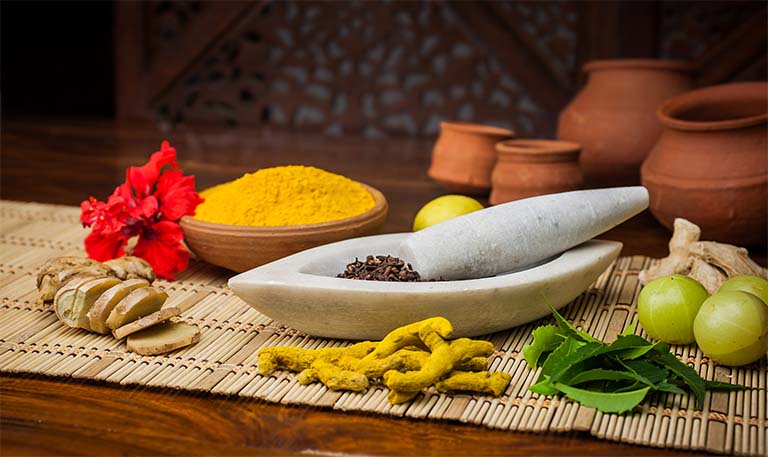By Virender Sodhi
Winter, 2010
The Ayurvedic approach to pain management is a holistic one. When treating a patient with chronic pain, I always advise an integrated approach, and look beyond the outward pain to discover the underlying source. Very often, chronic pain is caused by an inflammatory response within the body. Ayurvedic herbal treatments are effective for healing and controlling excess inflammation. For long-term results however, such treatments must be part of an integrative approach combining diet and nutritional changes, detoxification, and therapeutic exercise.
The science of Ayurveda is based on balance. According to Ayurvedic understanding, health is based on the balance of an individuals physiology, (Doshas) digestive processes, (Agni) tissues, (Dhatus) and excretion (Malas). The person, whose soul, senses, and mind are content, is considered to be healthy. The Ayurvedic approach seeks to restore physical, mental, emotional, and spiritual balance, by using nutrition, yoga, meditation, breathing exercises, herbs, and supplements.
In my decades of Ayurvedic and Naturopathic practice, I have treated many patients with chronic pain issues resulting from arthritis, osteoarthritis, fibromyalgia, dermatitis, asthma, colitis, Crohns disease, auto-immune diseases and cancer. Many of these have benefitted from the arsenal of wonderful herbs Ayurveda offers, to control inflammation at different levels.
Inflammation is actually the body's normal response to conditions such as infection, toxins, and trauma. Under normal conditions, once the negative event is over, the body will produce an anti-inflammatory response to restore balance. In cases of chronic pain, however, the body is not able to regulate the inflammatory response. The result is chronic imbalance and chronic pain.
There are many Ayurvedic herbs that address ongoing, excess inflammation. Among these are Salai (Boswellia serrata), proven in clinical studies to ease the pain of osteoarthritis, the priced spice turmeric (Curcuma longa), ginger (Zingiber officinale) known in Ayurveda as the universal medication, and the powerful herb Ashwagandha (Withania somnifera). Taken alone or in combination with other herbs, these natural pain relievers address chronic inflammation without the serious side effects many chemical pharmaceuticals cause. What follows, is a sampling of my clinical experience using these herbs for pain relief and control.
Boswellia serrata – Salai
This herb is unrivaled as a treatment for osteoarthritis. In a 2008 double-blind, placebo controlled study, Boswellia serrata produced very rapid results in patients with osteoarthritis, many of whom were bedridden. The patients pain scores and functional abilities were markedly improved, and blood levels of cartilage-degrading enzymes decreased. In another study, all of the osteoarthritis patients treated with Boswellia reported reduced knee pain, increased knee flexion, and increased walking distance. Swelling was also considerably reduced.
In a study using dogs, Boswellia produced improvements in intermittent lameness, localized pain, and stiff gait. All the external factors that aggravate lameness, such as lameness when moving and lameness after a long rest, diminished gradually.
I have used Boswellia with great success to treat patients with osteoarthritis, rheumatoid arthritis and psoriatic arthritis. With holistic combinations of herbal therapy, Karma detoxification, nutritional changes, and yoga, I have been able to take many patients off of prescription pain medications, including steroids.
Curcuma longa – Turmeric
My personal belief is that turmeric is responsible for the low cancer rate in India. Turmeric is a powerful antioxidant, anti-inflammatory, anti-carcinogenic, anti-microbial and hepatoprotective spice. I have used it with remarkable results in treating cardiovascular, and gastrointestinal disorders.
As a pain-reliever, turmeric is potent in treating every aspect of inflammation. Various laboratory studies have demonstrated that turmerics active principle inhibits the action of inflammatory agents, including phospholipase, lipoxygenase, cyclooxygenase 2 (Cox-2), leukotrienes, thromboxane, prostaglandins, nitric oxide, collagenase, elastase, and others.
Cox-2 inhibitors such as Celebrex and Vioxx were once touted as anti-inflammatory drugs without the side effects. However, many patients took these drugs for years before learning that they are associated with heart disease. Turmeric, on the other hand, has a much broader spectrum of anti-inflammatory activity than these drugs, without the side-effects. Turmeric has been used as a culinary spice in many areas of the world for centuries, and its safety for human consumption is well-established.









/GettyImages-93186932-569fd1d75f9b58eba4ad563e.jpg)

